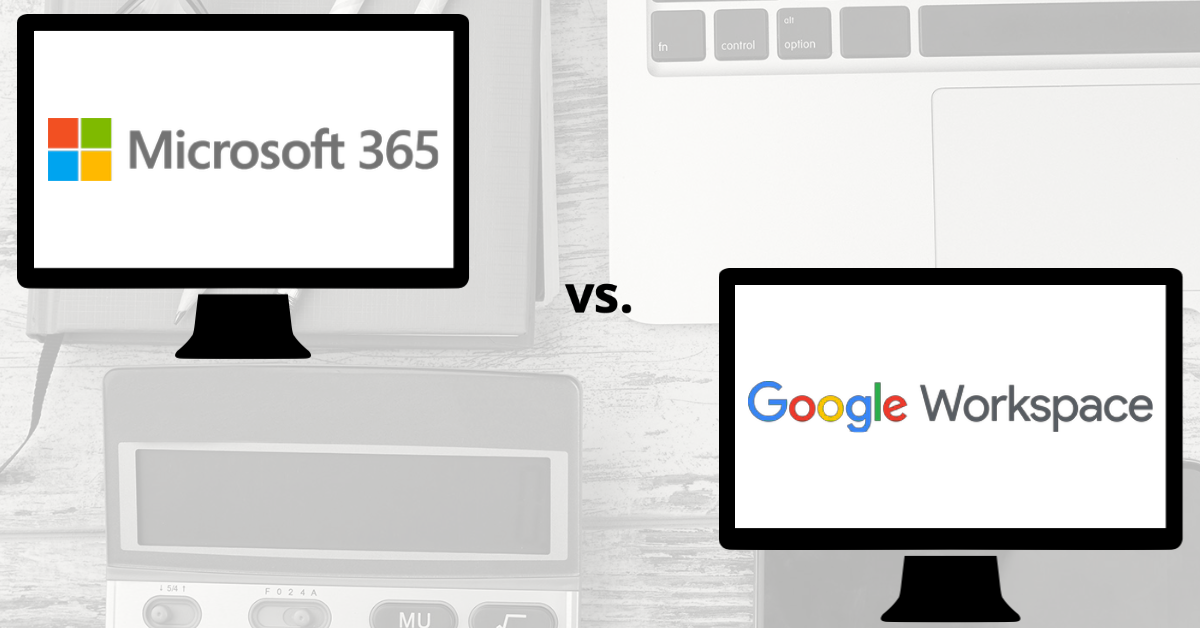When it comes to business productivity apps, you have a few options. Microsoft 365 and Google Workspace are arguably two of the most widely used.
They both offer a wide variety of different applications that can be used to communicate, collaborate, and stay on track with your tasks and projects. Although they check many of the same boxes when it comes to tools that your team needs, there are a few distinct differences between the two.
Plan Options
Both platforms offer a variety of different plans to choose from, depending on the needs of your organization and which apps you need your team to have access to. In most cases, the cost is priced by user per month.
Microsoft 365 does have a more extensive list of plan options, as they have a much wider range to choose from. However, Google Workspace also has a few different options to choose from depending on what your organization needs.
Communication
Both Google and Microsoft offer a personalized email suite, Gmail and Outlook, allowing you to use your organization’s domain name as your email address.
Both suites serve primary email functions, allowing you to quickly communicate with those inside your office and out. However, there are a few differences.
Gmail is sometimes perceived to be simpler, as the interface is a little less cluttered and cleaner. Outlook does have a bit more of a complex look to it, however, there are many more options when it comes to prioritizing and managing your inbox. Specifically, sorting, grouping, and adding labels to emails to help keep them organized.
Internal Messaging
As with email suites, both Google Workspace and Microsoft 365 also offer a communication platform for chatting and video calls – Google Meet and Microsoft Teams.
Google Meet supports video and voice-conferencing for up to 250 participants at a time, depending on the plan your business has. Meet does integrate with Google Calendar and Gmail to help you schedule meetings easily.
Microsoft Teams, on the other hand, supports video calls for up to 1,000 participants at a time, along with an easy-to-use chat messaging tool for co-workers. Teams also integrates with more than 250 other apps to help you communicate and collaborate with your team, no matter where they’re working from.
Collaboration Apps & Storage
Applications
Both platforms have multiple applications to support workplace collaboration, which is especially important in a work environment where you may have employees working from different locations.
When it comes to the basics (documents, spreadsheets, presentations, etc.), Microsoft 365 and Google Workspace are equipped with their own applications that support these types of programs.
However, the majority of Microsoft 365 plans offer desktop versions of the apps, along with cloud-based versions. This allows users to install the apps and work offline if they needed to. There are sometimes more formatting options within the apps when using the desktop version as well. In most cases, the Google Workspace apps are more simplified and basic in terms of formatting and tools within the app itself.

Storage
Another key difference between the two platforms is cloud storage.
With Google Workspace, your storage capacity varies depending on the plan that you purchase. Their storage options range from 30GB up to unlimited storage.
Microsoft 365, on the other hand, offers all users 1TB of cloud storage, no matter which business plan you purchase.
Security
One of the biggest differentiators between Microsoft 365 and Google Workspace is cloud security. While they both are secure platforms, Office 365 does take it a notch higher when it comes to security standards.
Microsoft 365 provides integrated security to safeguard your entire organization, not just access to your 365 account. Google Workspace security only protects access to Workspace itself, and does not provide protection for the rest of your organization’s environment.
When it comes to signing in to your account, Microsoft 365 employs multi-factor authentication that prompts users to give an additional proof of identification before gaining access. By requiring more than just a password, Microsoft makes it difficult for hackers to obtain or duplicate the forms of identification needed to log in. This works by requiring you to use two or more authentication methods:
- Something you know (typically a password)
- Something you have (such as a trusted device)
- Something you are (biometrics)
Google Workspace uses 2-step verification to help protect users. This works by prompting users to identify themselves using two things:
- Something you know (your password)
- Something you have (a trusted device or security key)
While this method does add a layer of protection for its users, Microsoft’s additional layer helps to keep accounts even more secure from potential threats. Google Workspace also integrates with many different third-party apps and extensions that can become risky as users grant permissions in order to use those apps.

In A Nutshell
If you’re looking for a business productivity platform that will allow your team to communicate and collaborate with each other, both Microsoft 365 and Google Workspace will do the job.
However, they differ in a few different ways. While Google Workspace may seem cheaper and more simple to use, it only does so much. Microsoft 365 takes productivity to a whole new level, along with adding an extra layer of security to help protect your users and your data.
In today’s atmosphere of steadily increasing cyber threats, you can never be too secure. The comprehensive security that Microsoft 365 provides helps to catch what other tools may miss, and strengthen your security posture across your entire organization.



